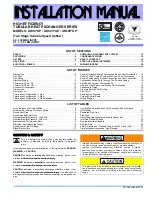
Page 13
3 − Low Voltage Terminal Strip TB1
A low voltage terminal strip (TB1) with thermostat markings is
located outside the control box. See figures 3, 4 and 5.
FIGURE 3
FUSE 2 AMP AGC FAST
BLOW
Q" SERIES TERMINAL STRIP TB1
GBLOWER DEMAND INPUT
WHEATING DEMAND INPUT
CCOMMON
*Y is used as a terminal block to
connect the outdoor unit to the
thermostat. It makes no internal
connection to unit controls.
R24VAC OUTPUT
YCOOLING WIRING
W
Y
R
G
C
V" SERIES IMC1 TERMINAL STRIP TB1
W1
W2
R
G
Y1
Y2
DS
C
HB
FIGURE 4
FUSE
3 AMP MDX SLOW BLOW
R24VAC OUTPUT
W11st STAGE HEATING DEMAND INPUT
W22nd STAGE HEATING DEMAND INPUT
GBLOWER DEMAND INPUT
Y11st STAGE COOLING CONNECTION
Y22nd STAGE COOLING CONNECTION
DSPWM, AC OR DC INPUT
CCOMMON 24 VAC
HBSENSING OUTPUT FOR HEATING
BLOWER
*Y is used as a terminal block to connect the
outdoor unit to the thermostat. It makes no
internal connection to unit controls.
V" SERIES IMC2 TERMINAL STRIP TB1
W1
W2
G
R
C
DS
Y2
Y1
FIGURE 5
FUSE
3 AMP MDX SLOW BLOW
NM
The following terminal designations are unique to V" se
ries with the
IMC1
motor:
R"
This signal provides 24VAC to the thermostat and, in
zoning applications, to the zone control.
DS "
This is the speed regulation input that switches the
blower from LOW to HIGH speed in cooling mode. DS is
the PWM (pulse width modulation) input in zoning ap
plications. When used with the CCB1 it is a 1217VDC
signal. When used without the CCB or Harmony it is a
24 VAC signal from the thermostat.
HB"
This is an output signal, to tell the zone control when
the electronically controlled blower is energized from
either a heating demand or a tripped secondary limit.
The following terminal designations are unique to V" series
units with the
IMC2
motor:
R"
This signal provides 24VAC to the thermostat and, in Har
mony II zoning applications, to the control center.
DS"
This is the speed regulation input that switches
the blower from LOW to HIGH speed, in cooling
mode. DS is the PWM (pulse width modulation) in
put in zoning applications that use Harmony II zon
ing system.
NM"
This terminal is used for non−zoning (Non−Harmony),
non−modulating applications where heat exchanger mod
ulation is
NOT
desired. The heat demand from the ther
mostat should be wired to this terminal
instead
of W1.
CAUTION
For units with the IMC2 motor do not connect the
heat demand wire to both the W1 and the NM ter
minals. Damage to the unit will occur. Use the W1
terminal for zoning (Harmony) applications and
the NM terminal for non−zoning (Non−Harmony)
applications.
W1"
This terminal is used for zoning (Harmony) modulating
applications where heat exchanger modulation
IS
de
sired. This terminal is also used for the first stage of a two−
stage heating application.
W2"
This terminal is used for two−stage heating. Two−stage
heating is not available when using the non−modulating
NM
terminal.
For field wiring to terminal strips see figures 3, 4 and 5. See
tables 2 and 3 for jumper connections.
TB1 TERMINAL STRIP JUMPERS V" MODELS
APPLICATION
JUMPERS REQUIRED
Single Stage Heating
TABLE 2
IMC1 MOTOR
HB" Jumpered to W2"
TwoSpeed Compressor, No
CCB1, Without Harmony
DS" Jumpered to Y2"
DS" Jumpered to G"
CCB1 With SingleSpeed or Two
Speed Compressor, Without Harmony
No Jumpers Required*
SingleSpeed Compressor,
No CCB1, Without Harmony
*Never Jumper Y2" to DS" when a CCB1 control is used.
Damage to the CCB1 will occur.
TB1 TERMINAL STRIP JUMPERS V" MODELS
APPLICATION
JUMPERS REQUIRED
TABLE 3
IMC2 MOTOR
TwoSpeed Compressor, No
CCB1, Without Harmony
DS" Jumpered to Y2"
DS" Jumpered to G"
CCB1 With SingleSpeed or Two
Speed Compressor, Without Harmony
No Jumpers Required*
SingleSpeed Compressor,
No CCB1, Without Harmony
*Never Jumper Y2" to DS" when a CCB1 control is used.
Damage to the CCB1 will occur.
Single Stage Heating
See Figure 13
For Pin Setting
NOTE − For single stage heat application with the IMC2 mo
tor, VSP2−1 will have a selector pin for single or second
stage heating. See figure 13.
Refer to tables 18 through 22 for a complete listing of all jump
ers used.












































